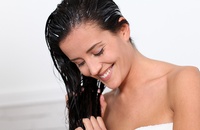
When we got the skinny on the best way to wash hair, our biggest takeaway was that people don't need as much shampoo as they think they do. In fact, some stylists say that you should stop using shampoo altogether. "It's something that's being talked about a lot right now in the beauty industry," said organic stylist Kristina Louise Welzien, who gave us some great advice as to how to stop using shampoo.
Hearing this, we decided to test that theory with a little experiment of our own to find out what happens when you stop using shampoo.
The Hypothesis
Giving up shampoo for 30 days can help regulate oil production, improving the condition of hair and scalp.
Kristina gave us four reasons why you might want to give up shampoo—at least for a little bit.
-
You use hot tools to style your hair. "Taking a break from shampooing . . . can do wonders for healing the hair," Kristina said.
-
You have highlights or change your hair color often. Cutting shampoo from your daily routine will help your hair's pH balance by restoring some natural moisture.
-
You get keratin or other straightening treatments. Kristina finds that "letting [hair] just chill out for a minute" helps prevent damage.
-
You have curly or textured hair. "In general [it] has a tendency to be more dry," Kristina said. Nixing the shampoo will allow hair's natural oils to condition it, improving curl pattern and reducing frizz.
Methods
Kristina's shampoo expertise helped shape our strategy. "If we use anything that's too astringent or too cleansing and we use it too often, it can actually have a reverse effect," she said. In layman's terms: the more often you wash your hair, the more oil your scalp tends to produce.
So to answer the question of how to stop using shampoo, she recommended a simple solution to remove the buildup of dirt and styling products on your hair:
-
Mix one part water and one part apple cider vinegar in a squeeze or spray bottle.
-
Apply to wet hair and let it sit for a few minutes.
-
Rinse thoroughly.
Subjects
Two of our editors courageously volunteered to stop using shampoo for 30 days. To help them in their journey, Kristina created individualized regimens for each of them based on their hair type and styling challenges.
Subject #1: Aimee

Hair type: straight, fine, medium thickness
Challenges: static, dry scalp, excess oil
Current routine: shampoos every other day; spritzes with a beach spray most days; more than one day without shampooing results in dry scalp and oily roots—what Kristina says is a common result of over-shampooing.
Her Regimen
-
Rinse hair every other day."It's important to give a day or [so] between rinses when you're not messing with it at all."
-
Brush or comb hair daily. Aimee purchased a boar-bristle brush to help better distribute her natural hair oils.
-
Use powder or dry shampoo when needed.
-
When hair is super-greasy, Aimee washed with a pure rinsing castile soap that promises to leave no residue.
-
Once a week, rinse scalp with the apple cider vinegar blend.
-
Take it easy on the styling products.
Her Observations
Day 7: "Greasy, greasy, greasy. I feel like everyone can see how gross my hair is."
Day 15: "Even [my husband]'s noticed how great my hair looks … I love it."
Day 22: "I don't think I'll ever buy a bottle of shampoo again."
Day 30: "I have not had a bad hair day since I got out of the greasy phase of this experiment."

Subject #2: Lisa

Kristina's instructions: Because Lisa's curls were dry, Kristina recommended rinsing just once or twice a week, then conditioning the ends. "Even if you're not shampooing, any time you get the hair wet you're drying it out," she explained.
Hair type: curly and thick
Challenges: split ends, dryness, dullness
Current routine: shampoos every other day; towel dries and after applying product, finger-twists strands to boost curl
Her Regimen
-
Rinse hair 1–2 times a week; condition the ends.
-
Brush or comb hair daily.
-
Once a week, rinse scalp with the apple cider vinegar blend.
-
Style with essential oil, spritzed onto hair from a spray bottle.
Her Observations
Day 7: "I just had my hair cut, but today my ends feel frayed … My scalp itches like crazy and I've been noticing more dandruff in between rinsing days."
Day 15: "I felt like the curls were really heavy and not very bouncy, but someone told me my hair looked clean, so at least it's looking better."
Day 22: "I cut my hair by myself, sans shampoo—and I LOVE it. I've never had a haircut I was really happy with, but it turned out exactly how I'd hoped … I've had several compliments, and people are surprised to discover I haven't been shampooing it."
Day 30: "My curly hair once again resembles what it was like when I was two and it was unmarred by products and people called me Shirley Temple. This is the greatest day of my hair-life."
Materials
You can find some of the products Aimee and Lisa used here:
Conclusions

Both Aimee and Lisa have fallen in love with their no-shampoo routines. Aimee's combination of oily scalp and dry hair has balanced out; Lisa says her hair feels softer and her curls are bouncier. They both plan to continue skipping shampoo for the foreseeable future.
Conclusion image by Matt Schwerin, Groupon. Progress photos by Kelly MacDowell and Mae Rice, Groupon.
This article has been updated from the original version by our editors.
RELATED READS:










